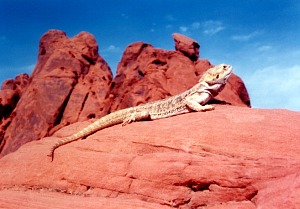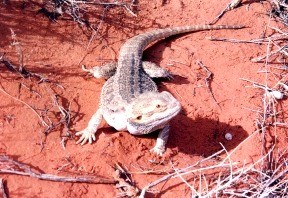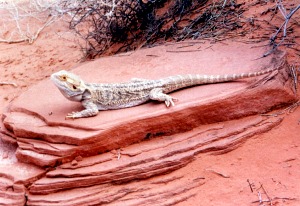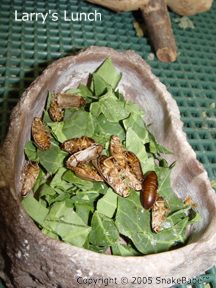Bearded Dragon Care
 Common Name:
Bearded Dragon
Common Name:
Bearded Dragon
Scientific Name: Pogona Barbata
Homeland: Australia
Size: Full grown is around 14 inches
Lifespan: 10 years (or maybe 1 if you use repti-bark)
Cage:
Best raised alone in a cage that will last them their lifetime. My adult is in a cage 4 feet high, 3 feet deep and 3 feet wide. A tree limb runs up the center to a shelf for him to hide and sleep. I will get people telling me beardies don't climb, but boy is mine active. I think if you give them the height they will use it. I love it because I can have it at 110 degrees at the top and 80 at the bottom, so he goes where he wants. Also, I provide a water bowl large enough for him to sit in with just enough water to reach his elbows. These guys do not need a lot of water, but change it at least every other day so it will be fresh if they do want some.
 Substrate:
Substrate:
I have found that Dri-dek (www.dri-dek.com) (the rubber mats used behind most Bars and in kitchens at restaurants or in shower stalls) work great. See my general care page. They are raised off the ground so the pee runs under and your pet is not always walking through it and it hoses off easy for cleaning and disinfecting. Wood chips and bark can hold mites, also they may ingest it and not be able to pass it. The rubber mats have lasted me over 10 years now. I often get asked about the calci-sand substrates because they advertise it is ingestible, but I still have people emailing me with lizards that get impacted from the sand, especially hatchlings. So I don't want to take a chance. If you want that desert feel, those dri-dek mats come in tan too.
Temperatures:
I use heat panels to control all my reptile cages tempertaures. (www.pro-products.com) Beardies are desert lizards and can tolerate high heat. But just because they can tolerate it does not mean it is comfortable so I use large caging on my little dudes. They can bask in an area just below the heat panel at 110 degrees and the bottom of the cage is kept at 80 degrees. So of course I use two thermometers, one up top and one on the bottom.
Feeding:
Hatchlings up to two months: two week old crickets twice a day at least. Dust the crickets with vitamins. Alternate crickets with finely chopped mixed vegetables and Kale. Variety is great for these omnivorous lizards. There is a commercial dragon chow like diet for them, which I also use, but not as a daily meal mabye every 3rd day. I add just enough water to soften the chunks and they gobble it up. Two to four-month-old dragons get medium crickets. Never wider than their mouths. Especially as hatchlings. This could kill them. As they pass the 4 month stage, adult crickets, dark green leafy veggies like mustard and collard greens. Mealworms may be fed. Also when they reach adulthood feed every other day. You can offer them frozen/ thawed pinkie mice once in awhile. Variety is important so offer everything. My dragons love roaches as well so a cockroach salad is yummy for them.
Lighting:
Sunlight and full spectrum light is a super must do! As often as possible you lizards should have access to direct, unfiltered real sunlight. Have a cage, NOT a glass aquarium but an open-air cage on your patio, in your yard or by an open window. Put your lizard in there and let him soak up the rays. He will feel better and get those bright eyes and beautiful colors you want. Please keep in mind if it is too hot you could cook the litle guy so make sure temps do not exceed their limits. Possibly place them in a tree shadow so the light is there but not too intense. This will provide UV radiation necessary for the synthesis of vitamin D and allow the reptile body to absorb calcium. In the winter this can be a problem. How can you put your sunlight needing reptile out in the yard when the cold will kill him? Answer is full spectrum lighting. I prefer natural sunlight, but is the next best thing. A florescent light tube (never the screw in kind) that copies a little bit of the sun. I have been using Vita-lite brand as far as I can remember with great success, but I believe they have sold to GE and I'm not sure if the bulbs are the same. I'm still looking into it. Another problem is that there are now a zillion lights on the market claming to have full spectrum capabilities, but I have used these with success for 1 years and still have healthy lizards, so why change.

This and That:
It is best to get them at few months old. About 3-4 inches in size. A bit costly to start up but smooth sailing after that.
SnakeBabe's Pet Rating: Excellent
They're great. What can I say? Good disposition. Hearty eaters. No humidity needed. Eat veggies from the grocery store, buy organic if you can. The perfect pet lizard. The cage can be a bit on the expensive side but one of my favorite pets. Go for it.
